It’s important to have an emergency food bank, but let’s be honest, most of us are also big fans of convenience.
If something is convenient, we’re most likely to follow through with it.
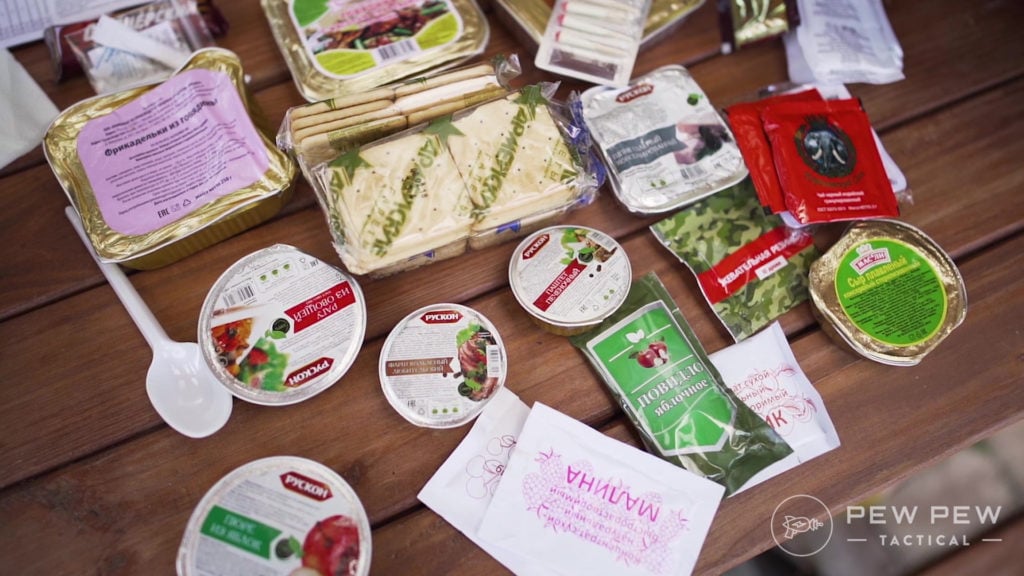
So, MREs hold a certain appeal as they provide a convenient means to store food for emergencies.
However, meals-ready-to eat are often quite pricey and may be well beyond what you are willing to pay.
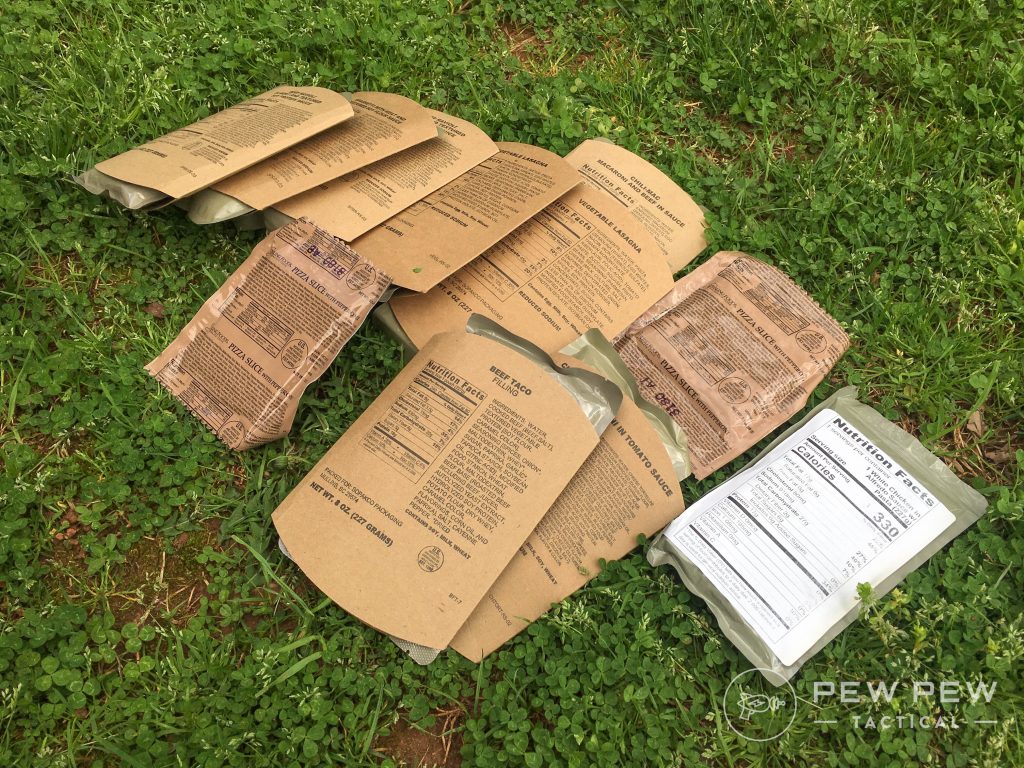
But lo and behold! Not all is lost! Because it’s possible to make your own MREs instead!
While these aren’t technically ready to eat right out of the bag – they require water and cooking –they’re the next best thing.
And they offer an incredibly cheap, convenient, and portable means of food ready when you need it!
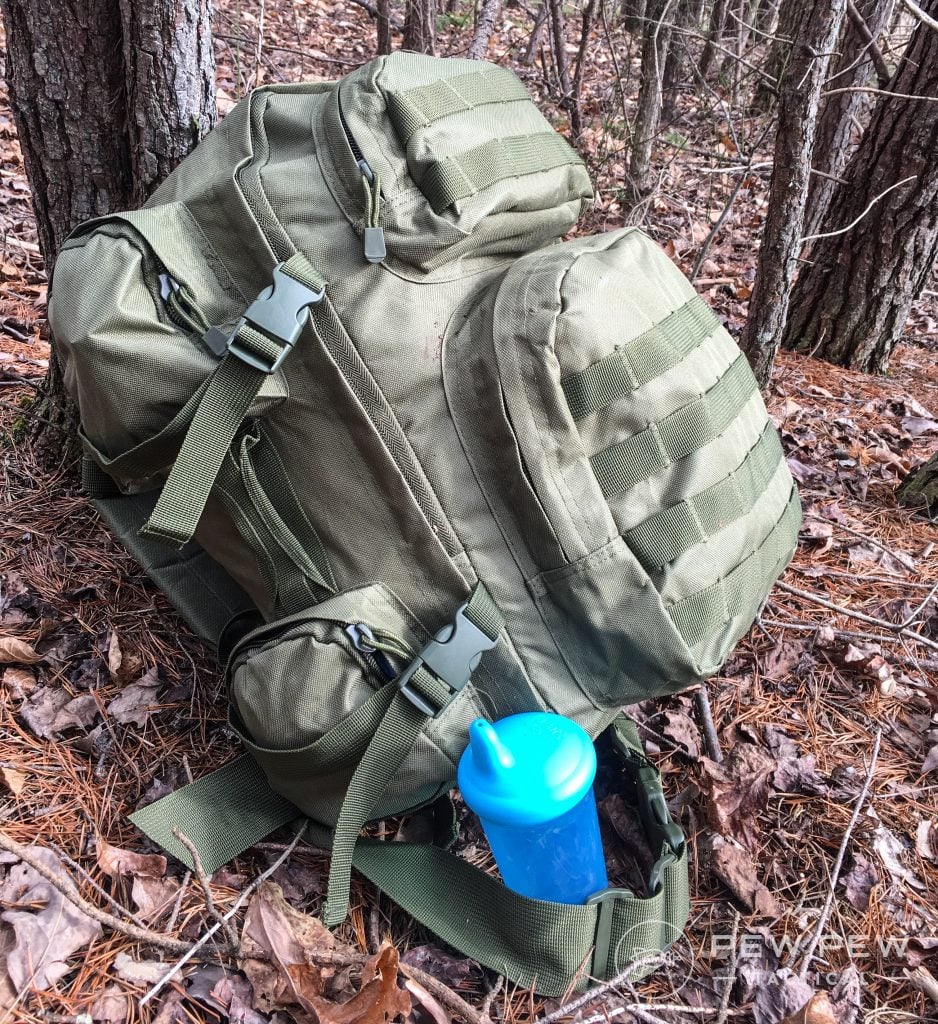
So, we’re going to help you out with your MRE meal prep. I’ve gathered nine of my favorite MRE recipes to get you started!
By the end, you’ll have a good selection of potential meals ready for bugging out (or in, depending on what you face.)
Table of Contents
Loading…
But First, A Few Supplies
Before you start meal prepping, there are a few supplies to gather up. I’ll list them below then we’ll talk about each a bit more in-depth.
Vacuum Sealer
Let’s get this out of the way up front…
To properly make your own MREs, you have to have a vacuum sealer.
Oxygen causes food to decompose quicker. So, the less oxygen comes into contact with your meals, the longer food lasts. No one likes to be on the run from zombies just to find out their food is rotten.
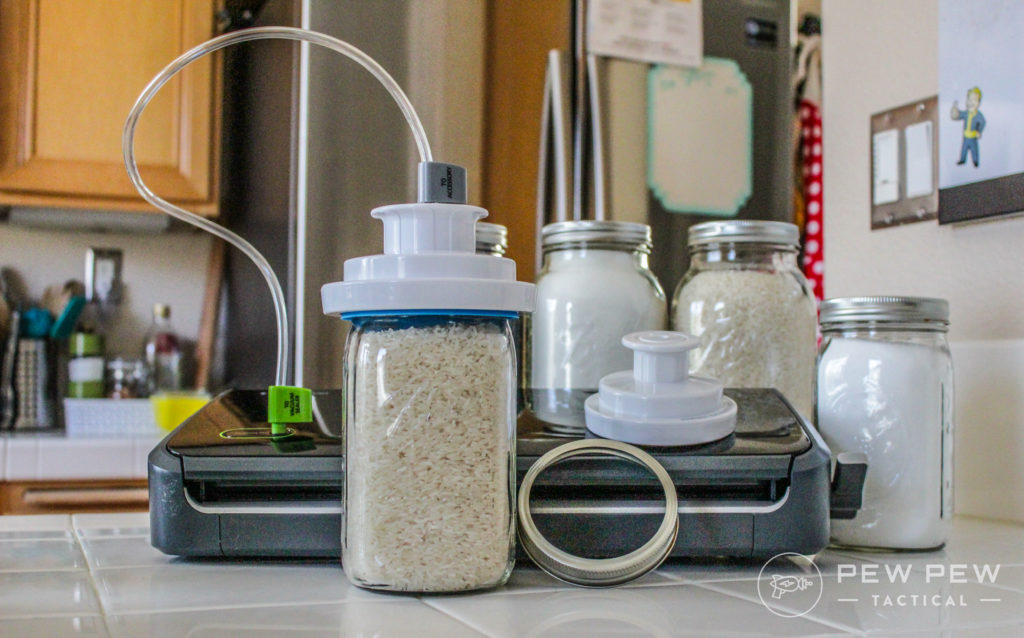
A vacuum sealer tackles this problem by taking all of the oxygen out of the bag.
This isn’t as big of an obstacle as you might think, though. You can easily find models available online that are all of $25.
-
25% off all OAKLEY products - OAKLEY25
Copied! Visit Merchant
I personally use the Geryon, which runs around $75, but it came with a decent supply of vacuum sealing bags already – a nice perk.
That said, if the vacuum sealer you choose doesn’t include a few bags already, you’re going to need to buy some of those as well.
-
25% off all OAKLEY products - OAKLEY25
Copied! Visit Merchant
Cookware + Water
If you throw a couple of these in a well-stocked bug-out bag, then you likely have everything that you need already.
Just don’t expect to be able to run out into the woods with nothing other than a DIY MRE in your hands.
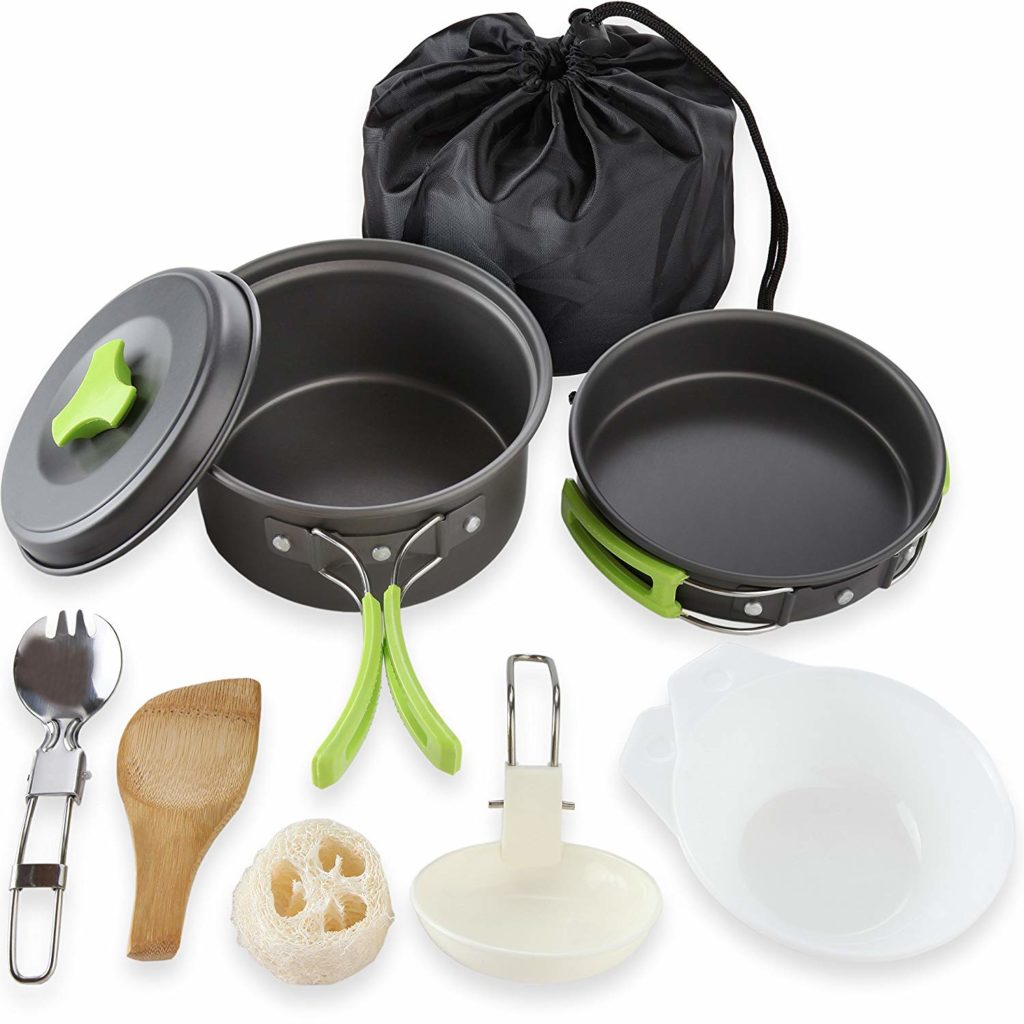
For all of the below recipes, you’re going to need a backpacker’s stove (or something similar), a bit of water, and two backpacker’s pots as well.
-
25% off all OAKLEY products - OAKLEY25
Copied! Visit Merchant
How can you source water on the run? Check out our recommendations for portable water filters to help you purify water in the woods.
Also, you need something to scarf all this good food down with!
You can definitely pack some plastic utensils in each bag, but for something more sustainable, throw some camping utensils in your pack.
-
25% off all OAKLEY products - OAKLEY25
Copied! Visit Merchant
Do-It-Yourself MRE Recipes
Seeing that an MRE is typically viewed as an emergency ration to be used while out in the field, these are by no means going to be low in calories.
Also, you’ll get a much more compact final product if you poke a few little holes in the ingredient Ziploc bags. Note: Do NOT poke holes in vacuum-sealed bags.
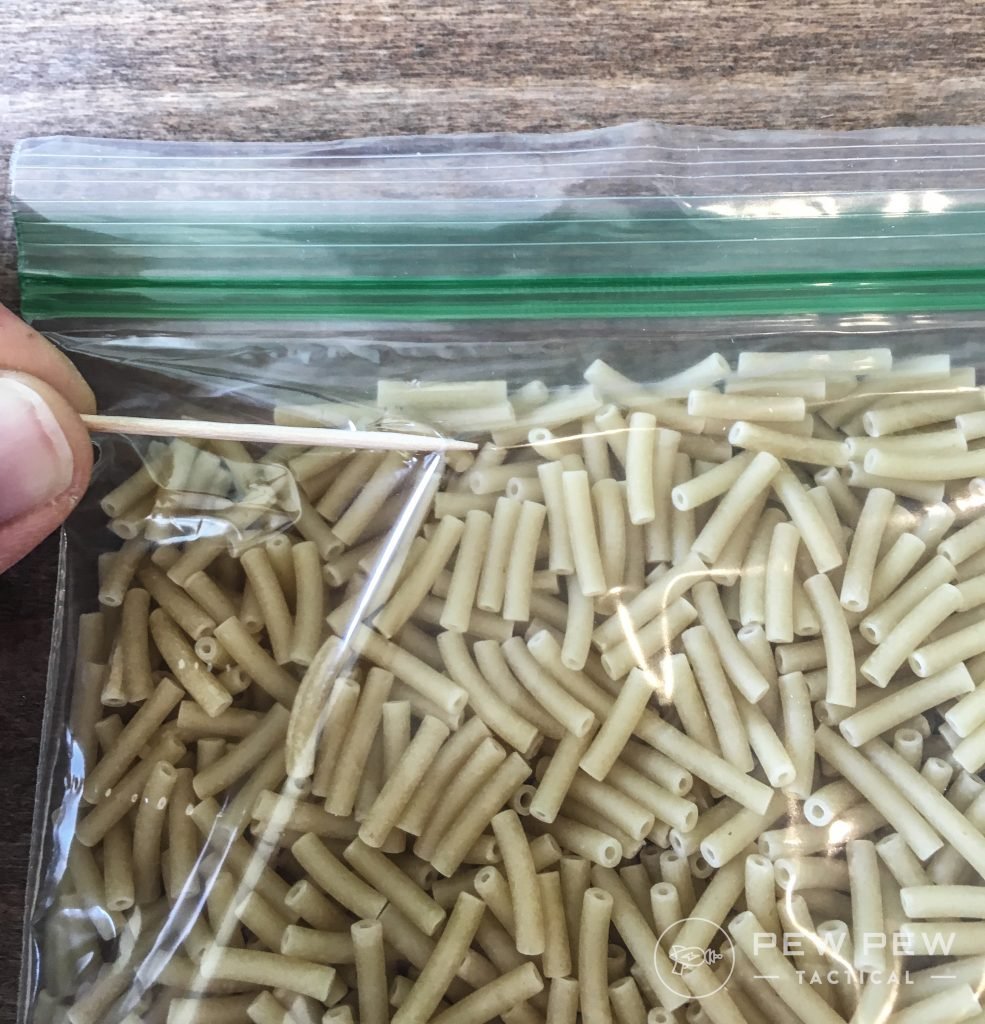
For example, if a recipe calls for a cup of flour, I pour that into a Ziploc bag, poke three to four holes in it with a toothpick, and then put it in my vacuum seal bag.
That way, the vacuum sealer sucks out as much air as possible.
Without further ado, let’s talk DIY MRE Recipes!
1. Banana Pancake Breakfast
Who doesn’t love pancakes in the morning — and what better way to pretend you’re Jack Johnson than to make banana pancakes?
This is an incredibly simple MRE recipe that requires minimal ingredients.
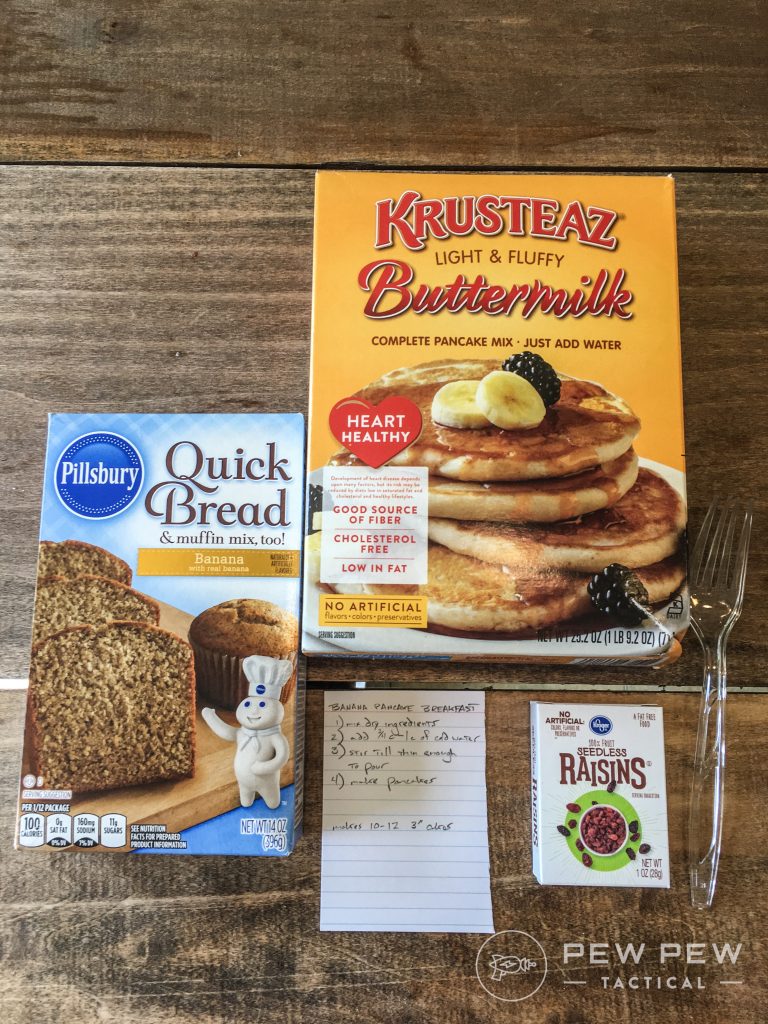
Initially, this was going to be a gingerbread pancake recipe.
But apparently, I become dyslexic as soon as I walk through a Food Lion door. That said, you could easily swap out a gingerbread mix here instead of a banana bread mix.
This one adds up to 710 calories.
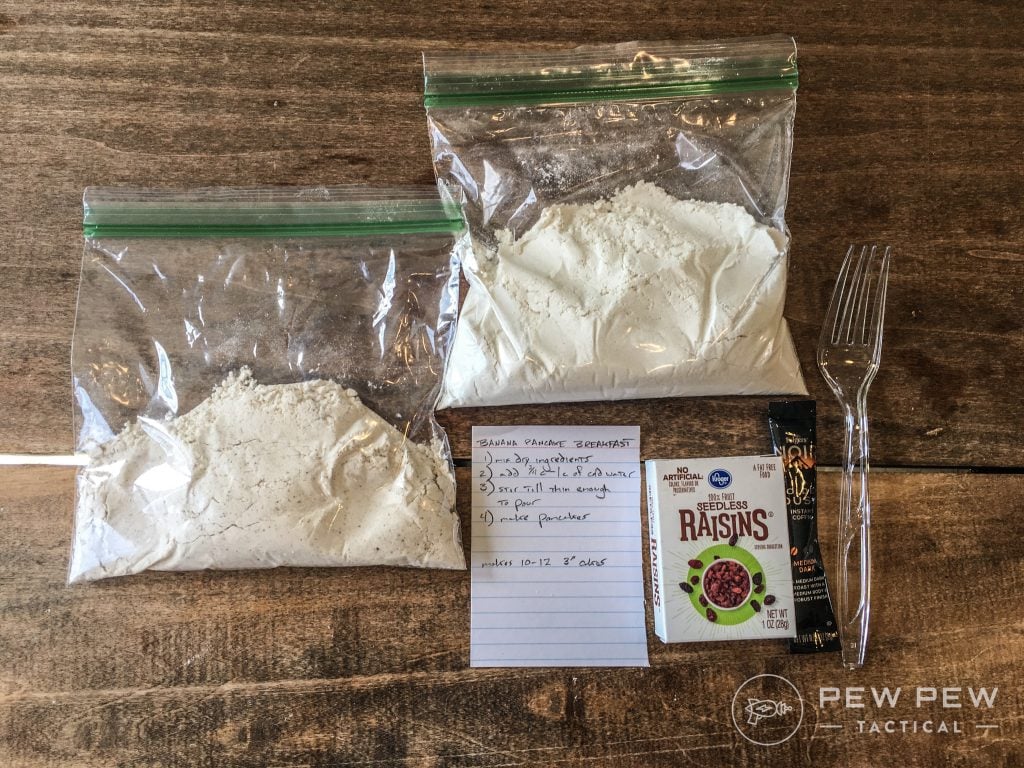
What’s Inside:
- 1 cup of pancake mix
- ½ cup of banana bread mix
- Instant coffee packet
- Small box of raisins
- A fork
To Cook:
First, mix together your dry ingredients. Once this step is done, add in ¾ to 1 cup of water. You want just enough to make a thin pancake mixture.
Stir in water until you get that, and then pour it onto a hot pan to make your pancakes.
Flip them when the edges are bubbly. Let them cook about a minute or two on this side, and they’ll be done!
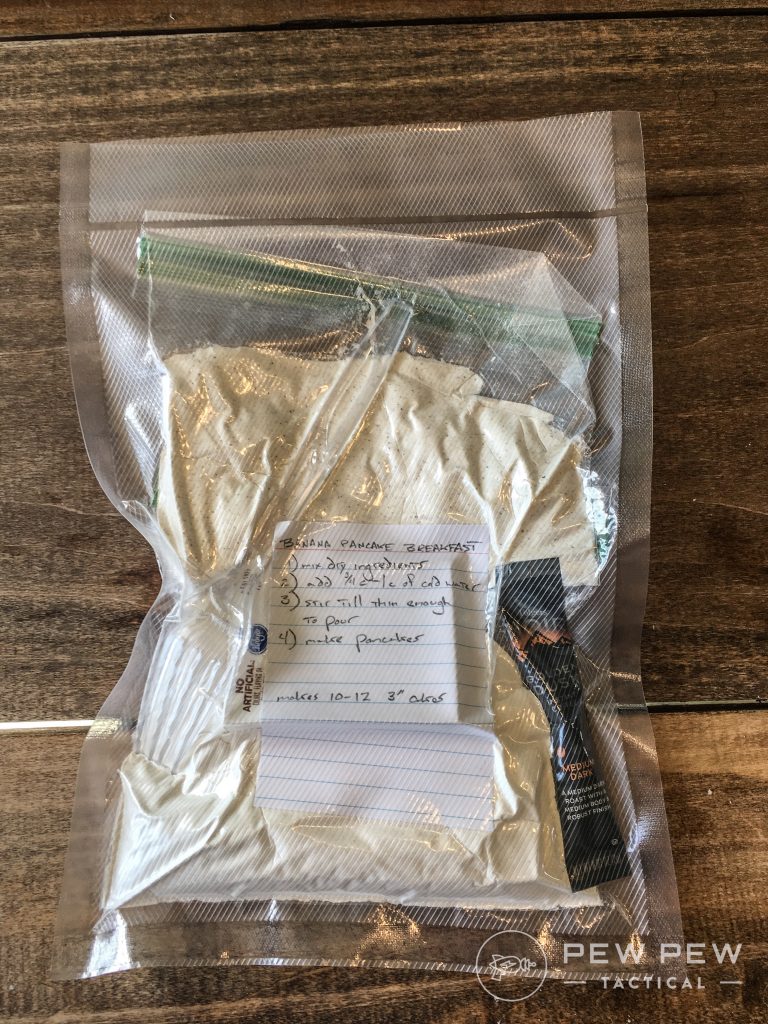
2. Oatmeal-in-the-Woods
I’ve eaten enough oatmeal while backpacking to know that it always needs a little something extra.
That’s why I try to make my breakfasts a bit more substantial. They’re what helps get me moving in the cold forest mornings.
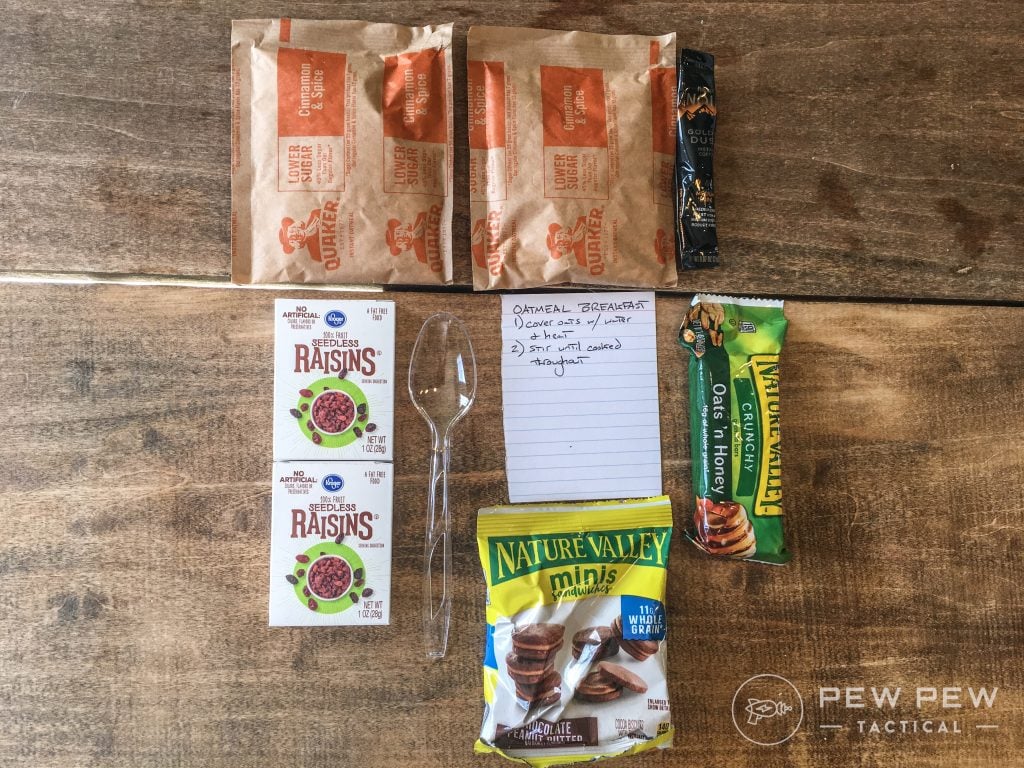
This meal will fill you up but not leave you feeling like a slug with 670 calories that are predominantly carbohydrates.
What’s Inside:
- Instant oatmeal (2 packets)
- Raisins (2 little boxes)
- Instant coffee packet
- Nature Valley granola bar
- Nature Valley mini sandwiches
- A spoon
To Cook:
All you have to do here is add water till you’re just barely covering the oats. Then, heat this thing up until it’s the desired temperature.
Stir throughout so that you don’t burn the oats on the bottom.
After it’s warm enough to your liking (which typically takes around 5 minutes), stir in the raisins.
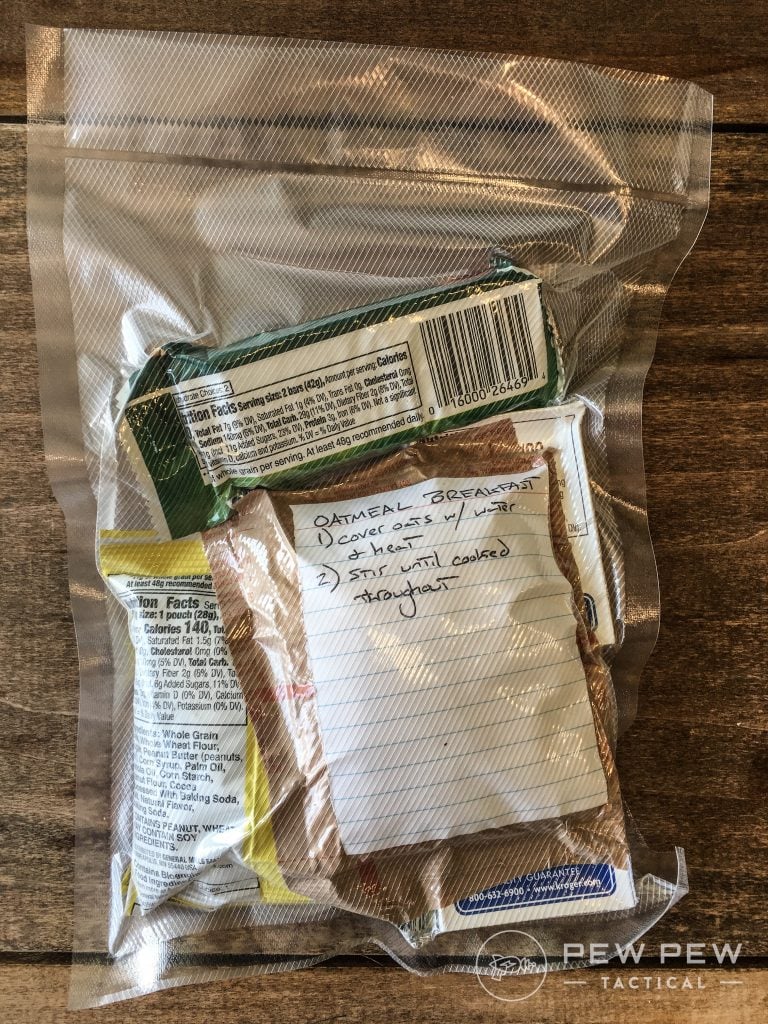
3. Biscuits and Gravy
Perhaps you’re not a big fan of oatmeal for breakfast, and you want something a wee bit more satisfying.
Something that’ll really hit the spot and “fill up the corners,” as Tolkien’s hobbits are fond of doing.
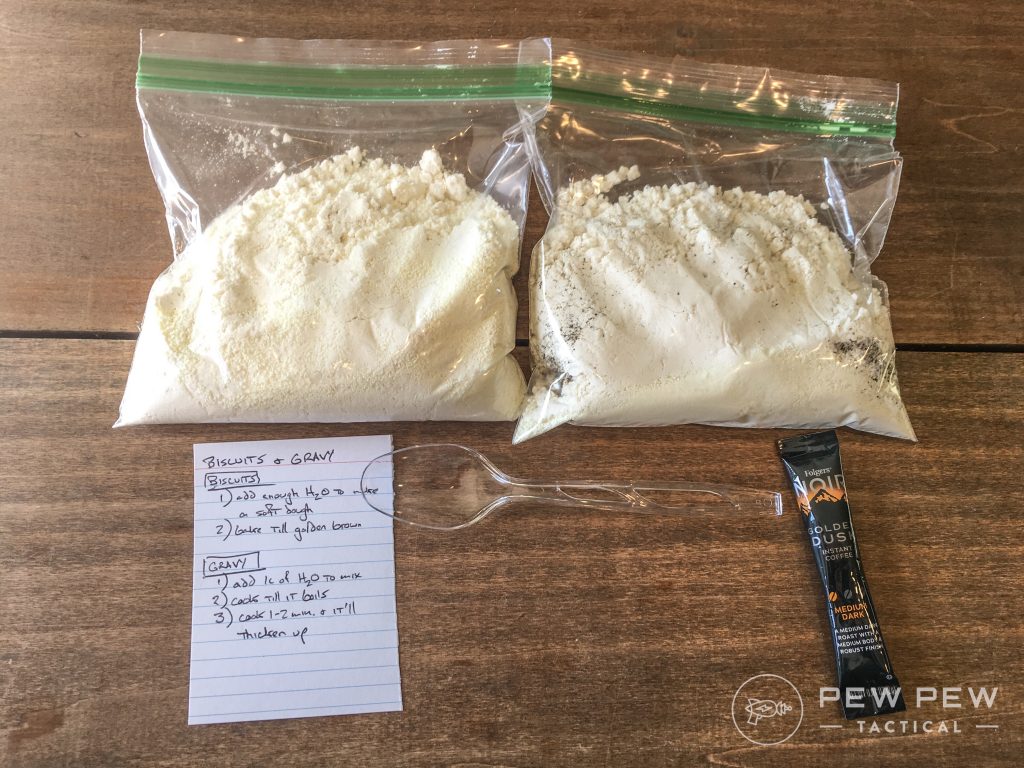
In such a case, biscuits and gravy are likely to do just that. This one weighs in at 1,128 calories.
What’s Inside:
- Biscuit mix
- Gravy mix
- Instant coffee packet
- A spoon
Biscuit Ingredients:
- 1 cup of baking mix
- ¼ cup of evaporated milk
- Gravy Ingredients
- ¼ cup of evaporated milk
- 1 cup of baking mix
- ½ tsp of salt
- 1.5 tsp of pepper
To Cook:
I recommend starting with baking your biscuits first. Just be aware that you’re going to need two pans to make this.
To start, take your biscuit mix and add just enough water to make a soft dough. After that, put it on top of your stove and bake it until you end up with a big golden-brown biscuit.
As the biscuit bakes, start working on your gravy.
First, add roughly one cup of water to the gravy mix.
Stir it together really well, and then cook until it boils.
Once it boils, let it cook for about 1 to 2 minutes. The gravy will thicken up real nice.
Drizzle this all over your biscuit, and you’ve got yourself a meal!
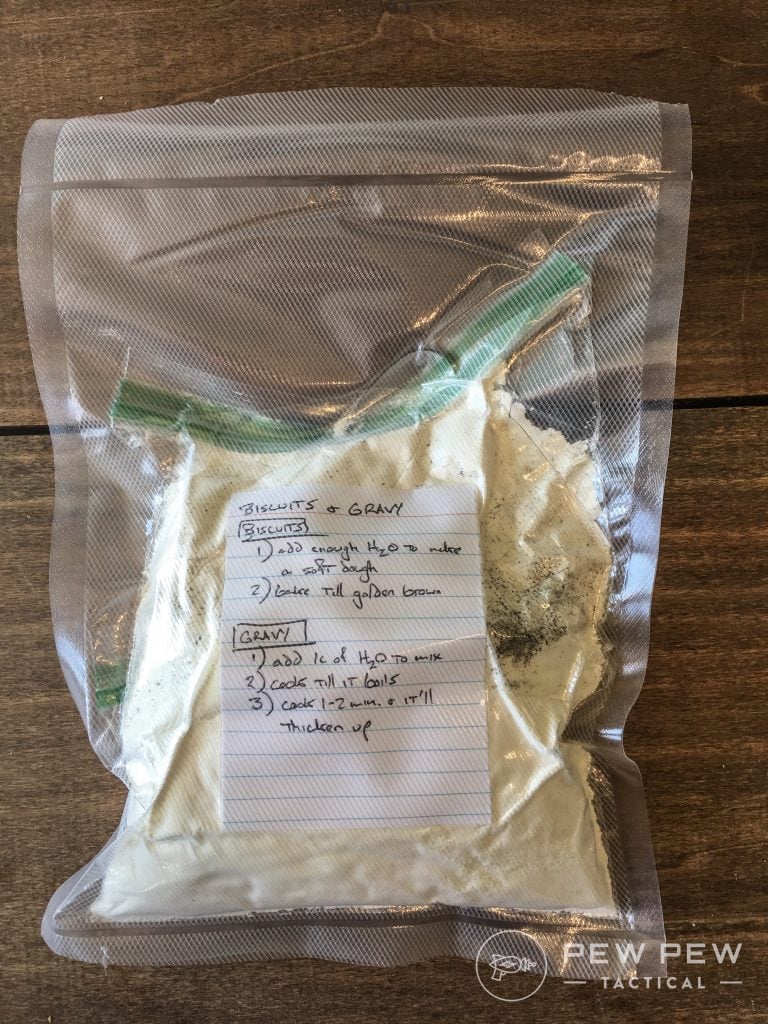
4. Macaroni and Cheese Dinner
This is likely one of the cheapest recipes on this entire list. (I paid just over a dollar for everything.)
This makes for a pretty hearty evening meal with little fuss too. If you’re exhausted and just want to climb into your sleeping bag, go with this one.
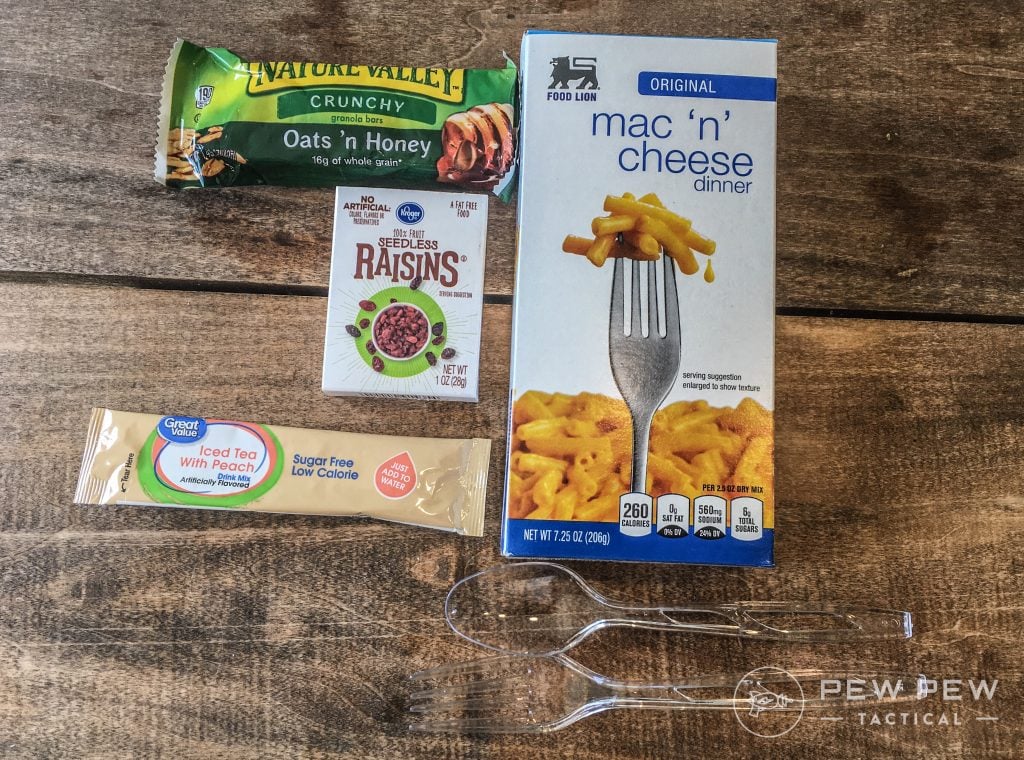
It offers up 1,110 calories.
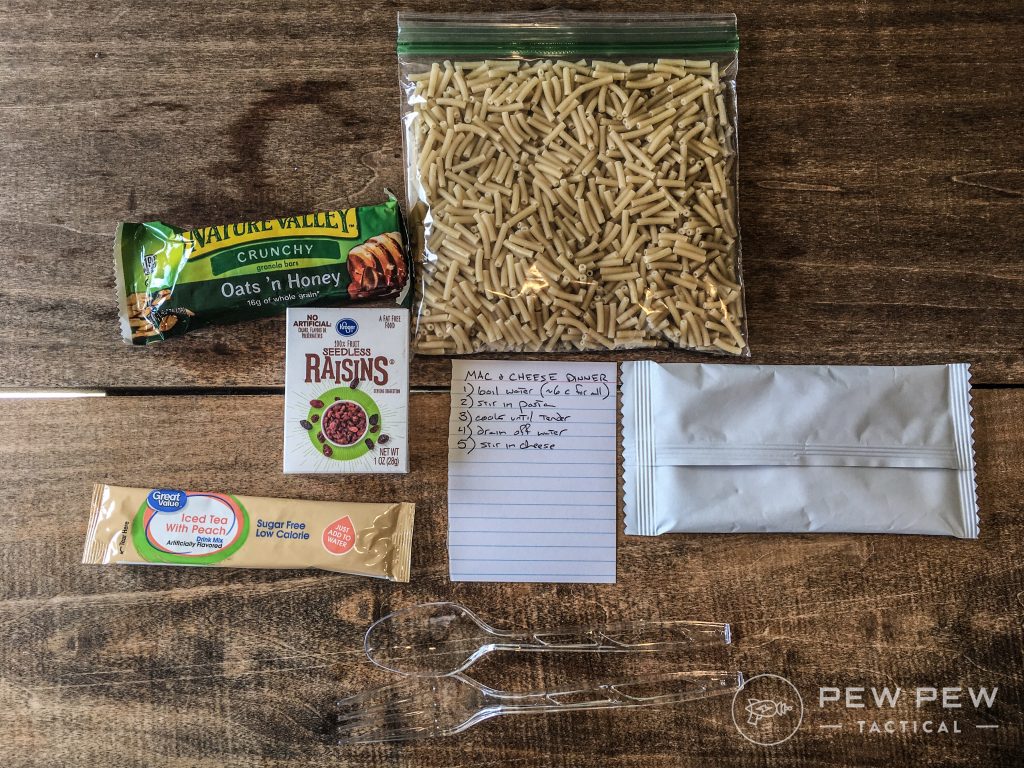
What’s Inside:
- One box of macaroni and cheese
- Nature Valley granola bar
- Instant peach tea
- Miniature box of raisins
- A spoon
To Cook:
First, boil a pot of water, then stir in your noodles. Cook these until they’re tender.
I start testing the noodles after a couple of minutes of cooking, squishing them with my spoon to see if I like the consistency yet.
Once they’ve reached a desirable level of softness, drain off the water.
Then, stir in the powdered cheese packet. You now have macaroni and cheese that just needs to cool a bit before it’s ready to eat!
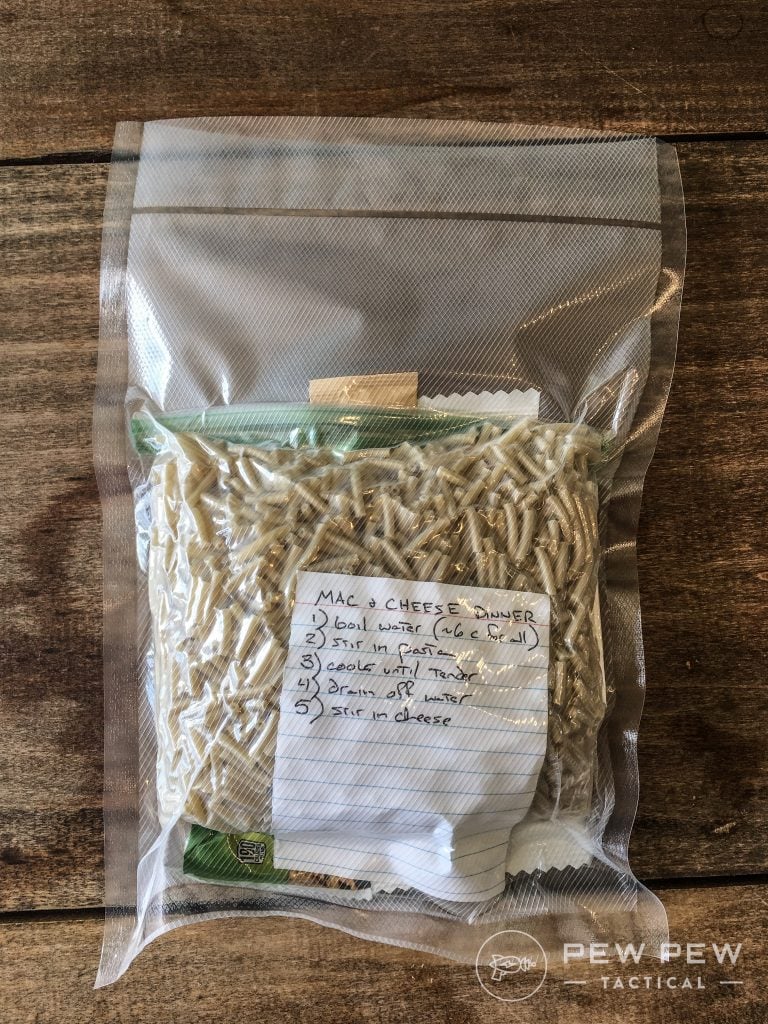
5. Fried Rice and SPAM
Before you get all in a tizzy because I’ve got SPAM listed, hear me out.
It’s by no means health food, but it does taste good, and it lasts a pretty respectable amount of time.
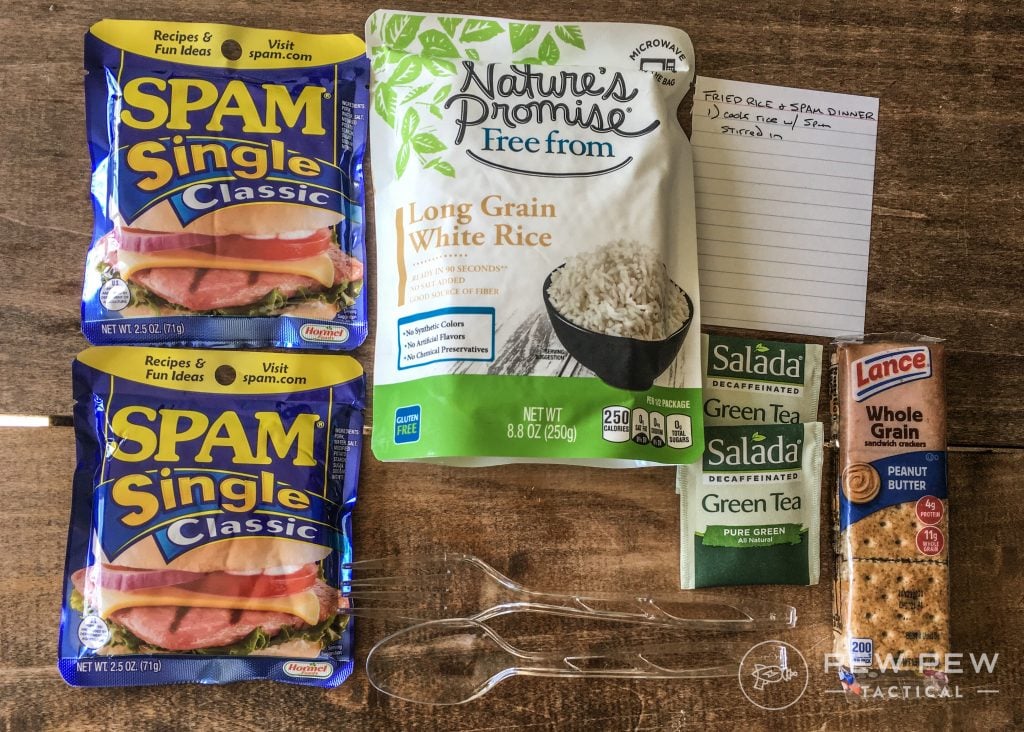
All of this makes it a great choice for DIY MREs.
If you try it, you’ll really like it. All in all, this MRE has 1,160 calories.
What’s Inside:
- Spam single classic packets (2 of them)
- Nature’s Promise white rice
- Peanut butter crackers (6-pack)
- Green tea (2 bags)
To Cook:
This one’s pretty simple.
Start cooking your SPAM in your backpacker’s pot, and then stir in the rice.
The fats from the SPAM will help keep the rice from sticking to the sides of the pot and burning. Keep stirring to ensure no burning takes place.
Cook until it’s warm enough to eat.
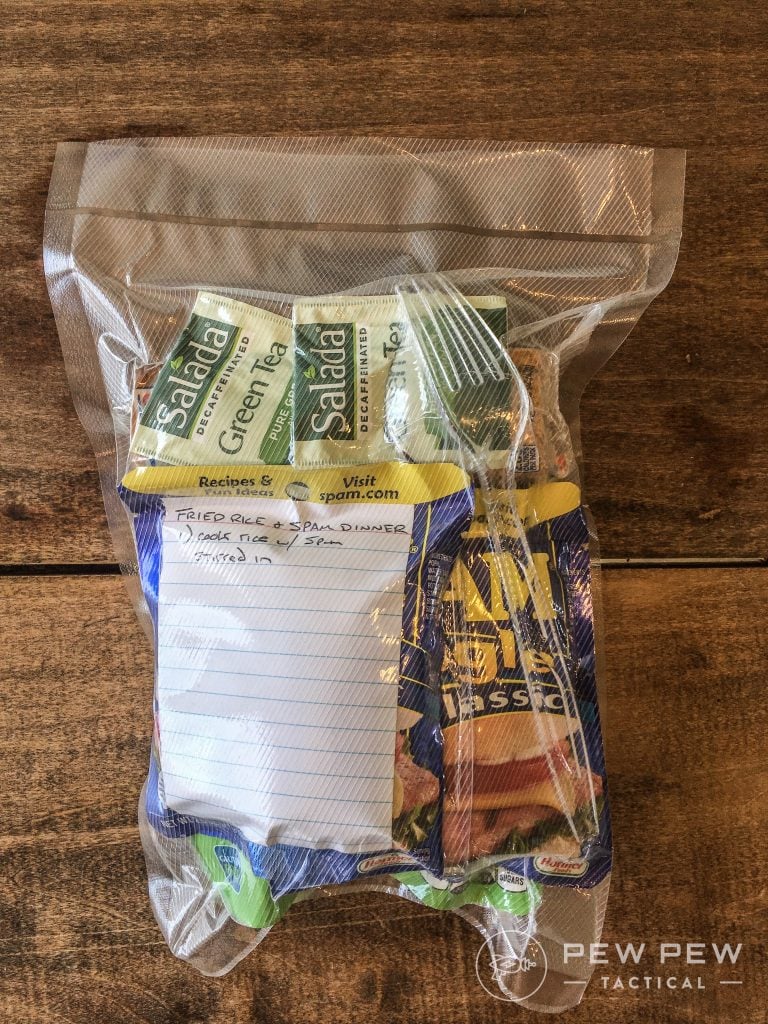
6. Lentil Casserole
Lentils are a great legume for backpacking because they cook much quicker than other types of beans.
If you can find them, instant lentils cook even quicker.
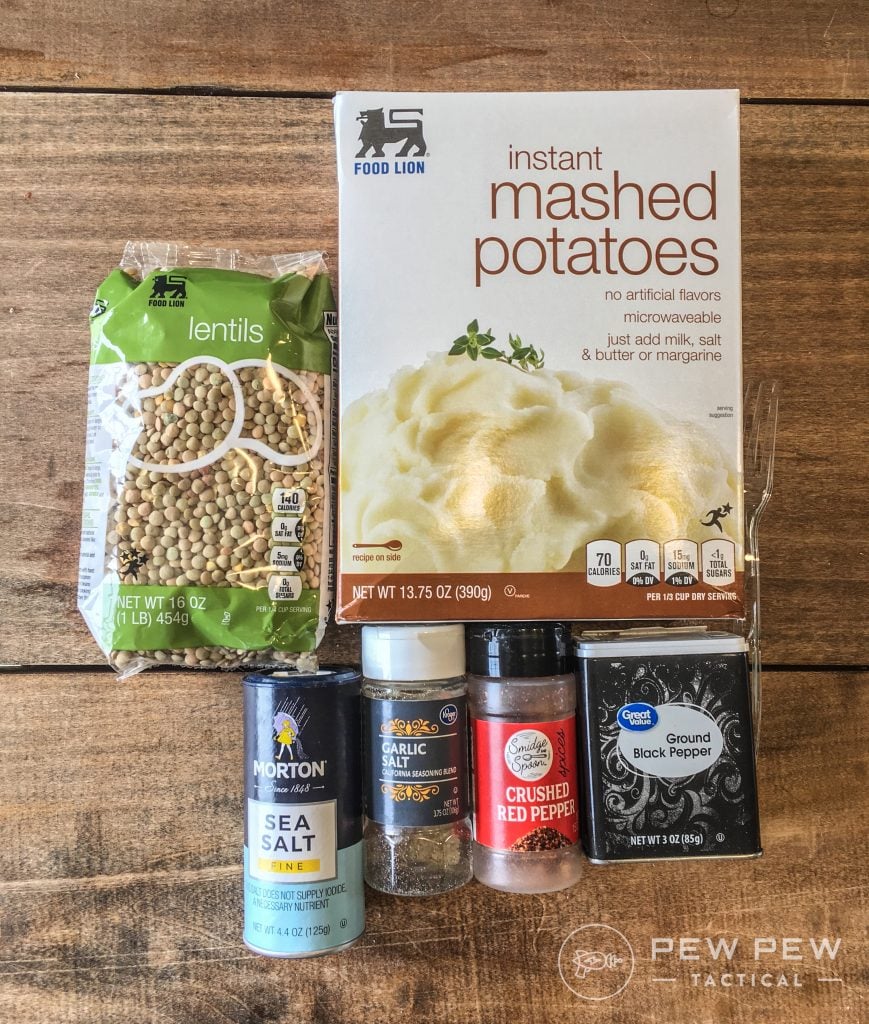
This dish is rather hearty but can easily have other ingredients added to it for further flavor.
You can improve this dish with cheese, but just make sure you have a version that will last within an MRE. (Beef jerky/cheese combos may be a suitable version for this.)
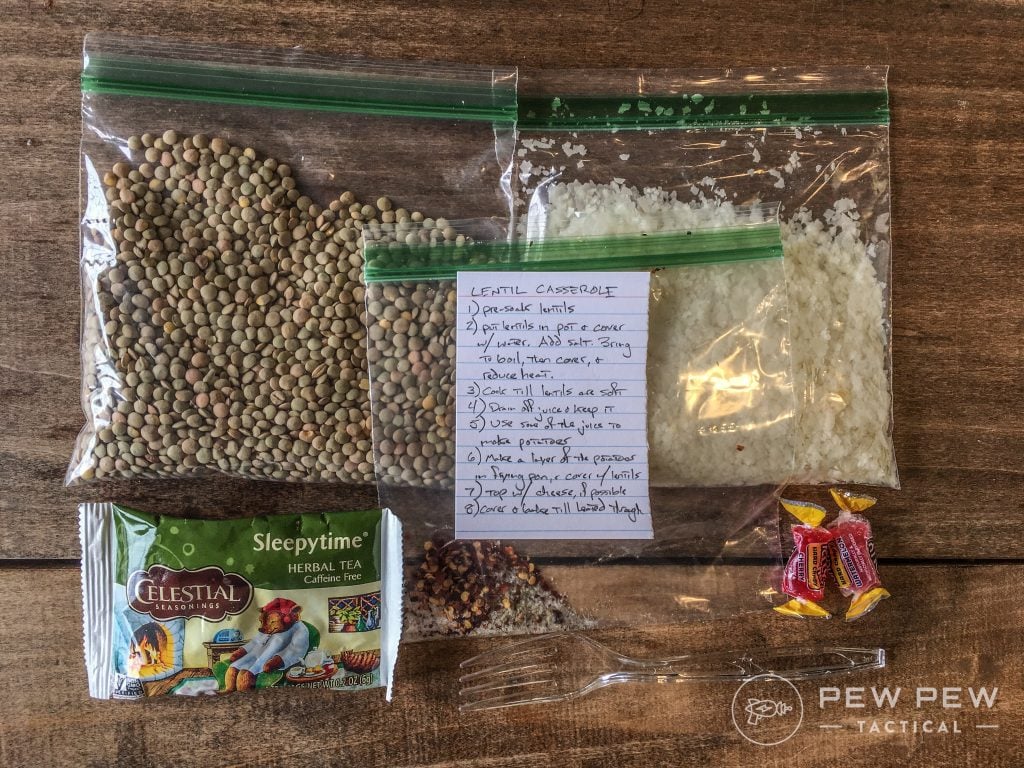
As it is without all that, though, this MRE comes in at 846 calories.
What’s Inside:
- Jolly ranchers (2)
- Celestial Sleepytime teabag
- Lentil casserole ingredients
Lentil casserole ingredients:
- 1 cup of lentils (preferably instant lentils)
- 1 tsp salt
- 1 cup of potato flakes
- 1 cup of cheese (if possible)
To Cook:
First, soak your lentils for a little bit, if possible. This will help them to cook quicker.
They’ll puff up quite a bit when they’ve soaked up water. After, put your lentils in a pot, and cover them with about an inch of water.
Stir in your salt, and bring the lentils to a boil. Cover and reduce the heat.
Cook roughly 20 minutes until the lentils are soft.
After which, drain off the juice into your potato flakes and mix them up.
With your potato mixture, coat the bottom of a pan to create a crust, and pour the lentils evenly on top.
Cover the casserole and bake until it’s heated through.
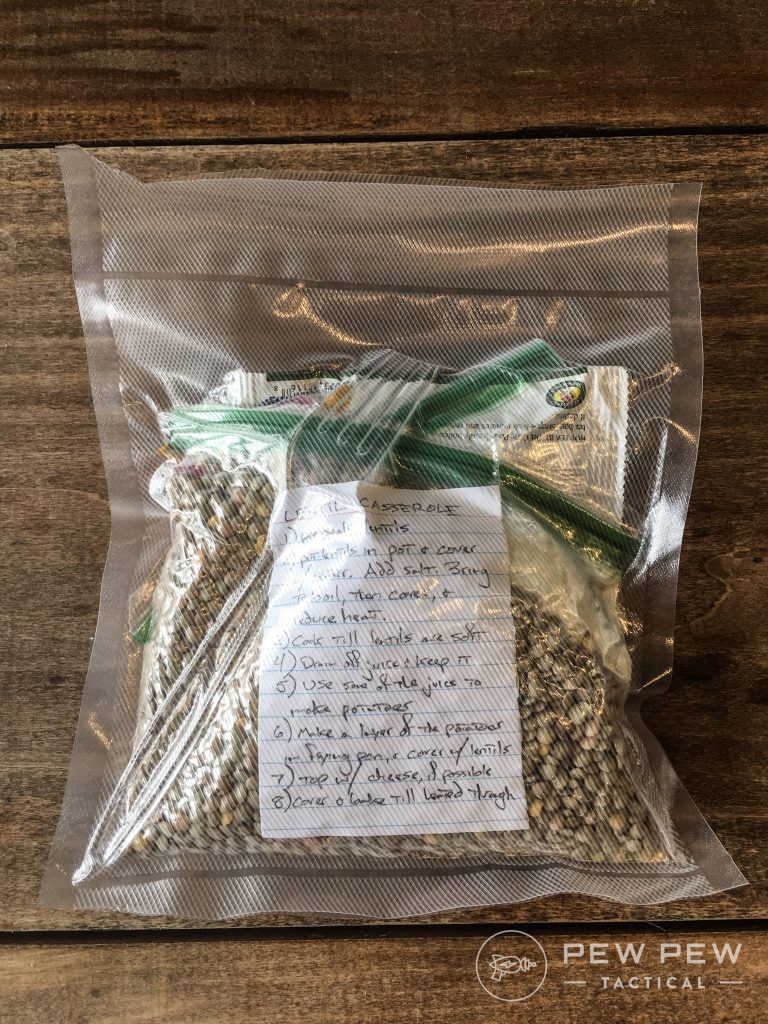
7. Soup and Dumplings
I love soup and dumplings. They’re a fantastic way to warm yourself after a cold day’s worth of hiking through the elements.
Not to mention, they always remind me of my Granny’s cooking. We eat these a lot in the beautiful South.
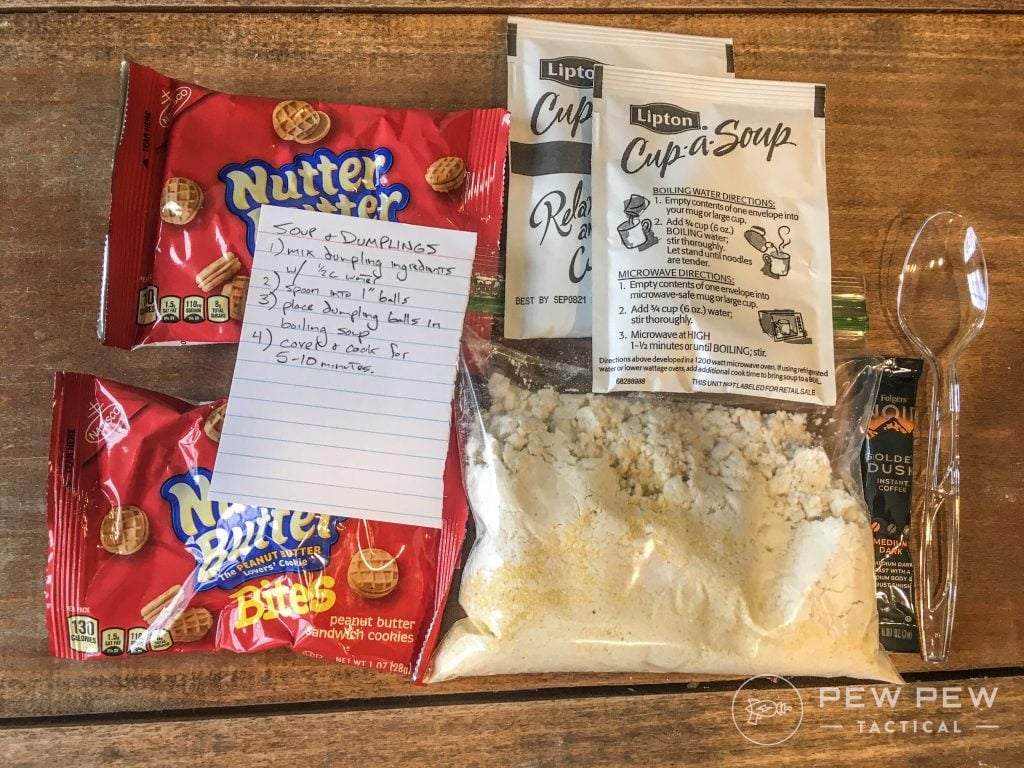
This is an incredibly hearty dish at 1,028 calories.
What’s Inside:
- Miniature Nutter Butter packets (2)
- Cup-a-Soup packets (2)
- Dumpling ingredients
- Instant coffee
- A spoon
To Cook:
First, pour the soup packets into some water and get the water boiling.
While you wait, mix your dumpling ingredients with roughly ½ cup of water.
This will make a doughy mixture that you’re going to want to stir together really well. Spoon this mixture into balls about 1-inch in size. Once your balls are made, put them in the boiling soup.
All you have to do now is cover the soup and let it cook for 5 to 10 minutes!
Voila! You’ve made soup and dumplings!
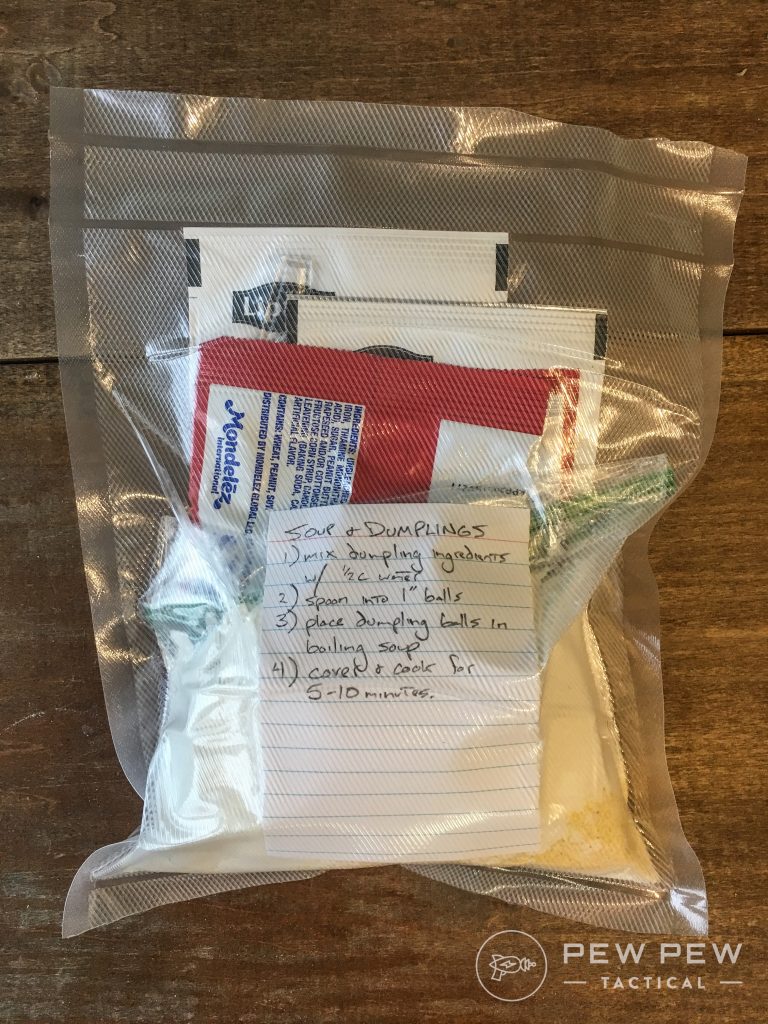
8. Soup and Bread
Here, yet again, we find my fondness for soup at work.
The fun thing about this recipe is that if you have bread left over, you get to save it for later to munch on. I’m a huge fan of leftovers, so that’s an automatic win for me.
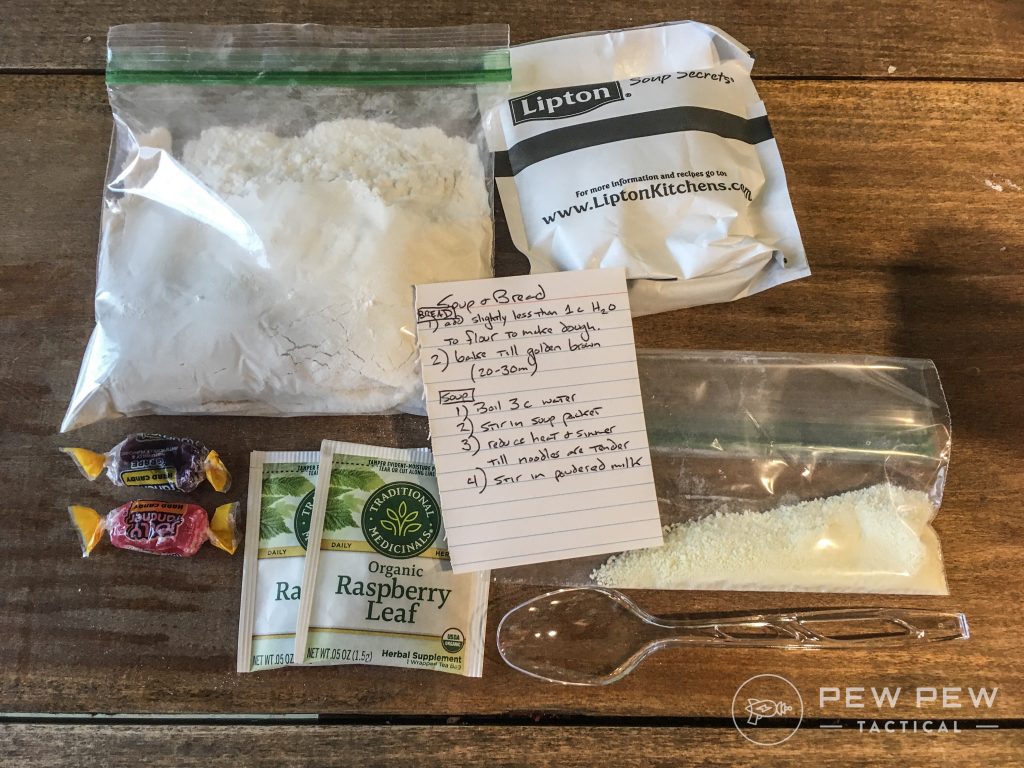
Calorie-wise, this is a heavy hitter and comes in around 1,536 calories.
What’s Inside:
- Instant chicken noodle soup (1 packet)
- Bread ingredients
- Jolly ranchers (2)
- 1 tbs evaporated milk
- Peanut butter cookies
- Raspberry tea packets (2)
- A spoon
Bread Ingredients:
- 1.75 cups of flour
- 1 tsp salt
To Cook:
First, mix your bread ingredients with enough water to make a dough. This will end up being just a little more than ¾ cup of water.
Don’t knead the dough but fold it over 5 to 6 times instead.
Once you’ve done this, bake until it’s golden brown. This should take anywhere between 20 to 30 minutes.
Now that you’re bread has been made, set it aside to cool.
You’re going to work on your soup now.
Get your water hot, then dump it in the soup packet. Heat until it’s to the temperature that you like.
After you’ve got the temp right, stir in the evaporated milk. This will help thicken up the soup a bit.
Set aside to cool and dip the bread into the soup as you enjoy.
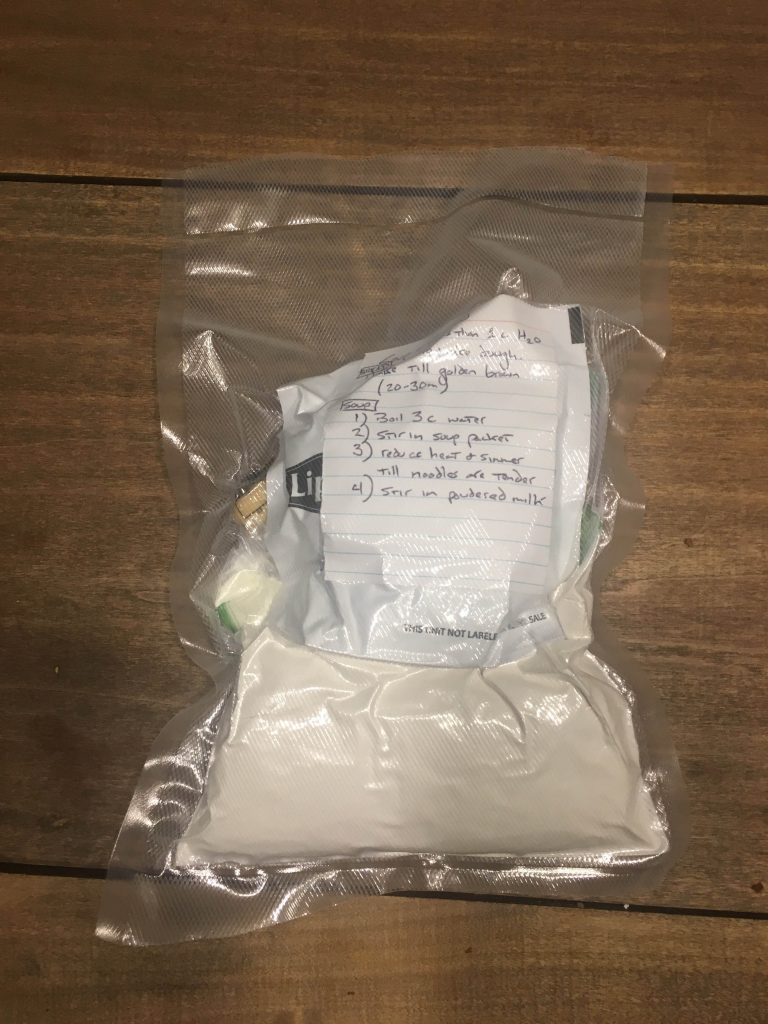
9. Potato Soup
Why is soup so often an MRE?
Because it’s easy to make, the ingredients are lightweight, and the MRE can store for a significant amount of time.
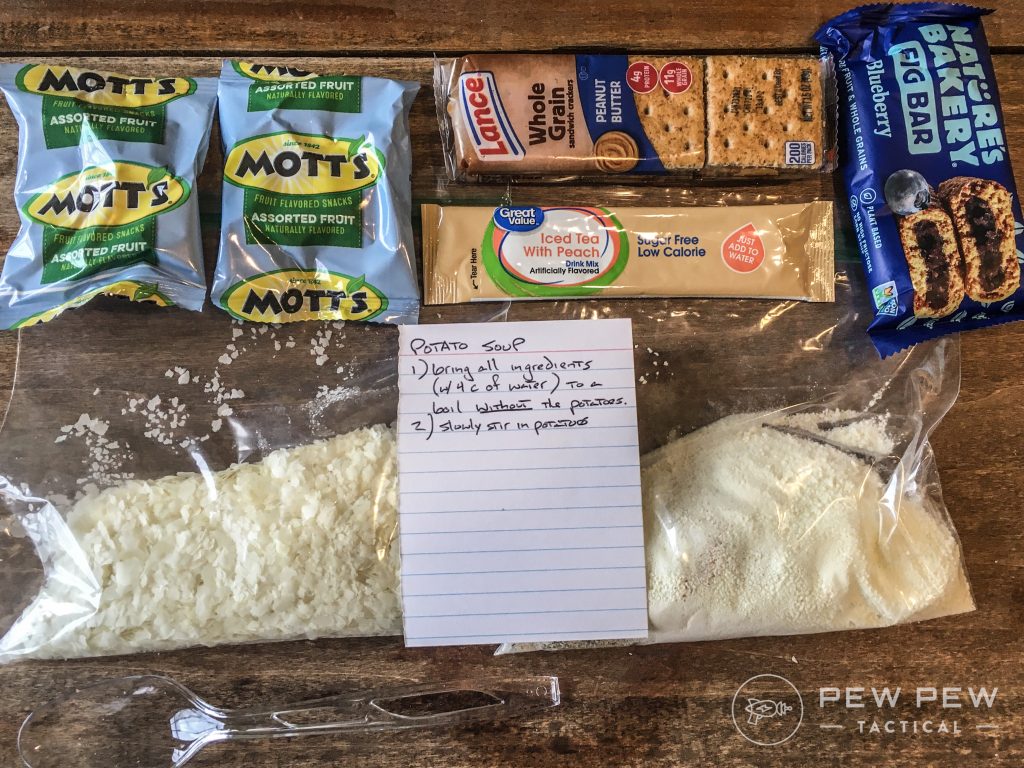
This MRE runs around 904 calories.
What’s Inside:
- Instant peach tea mix
- Fig bar packet
- Peanut butter crackers
- Gummies (2 kid packs)
- A spoon
To Cook:
Set the potato to the side, and mix the rest of the soup ingredients with roughly 4 cups of water.
Bring this to a boil.
After you’ve done that, reduce the heat, and then slowly stir in the potatoes. You now have potato soup!
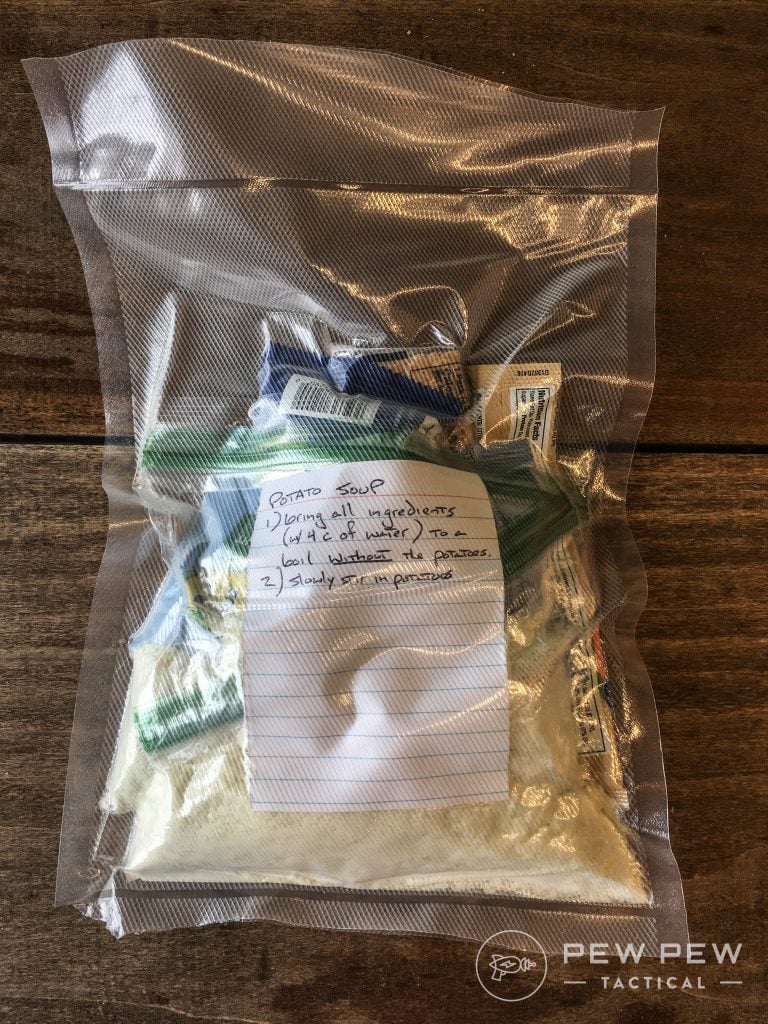
Conclusion
Making your own MREs rather than buying them can save you a great deal of money in the long run.
However, you need to ensure you’re doing everything in your power to store fresh ingredients that will last as long as possible.
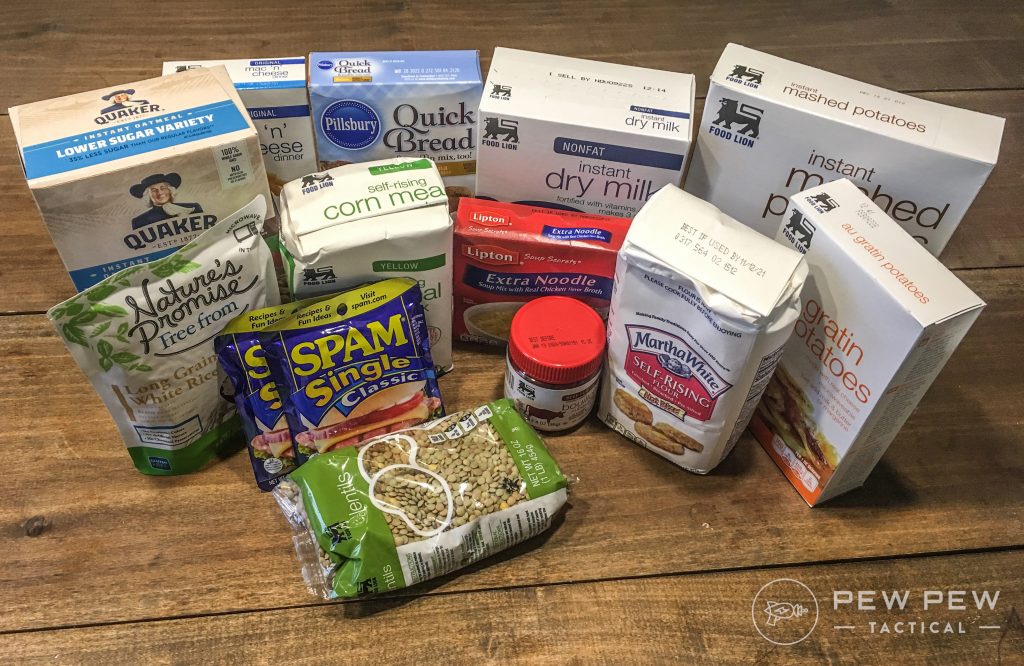
An MRE is only as good as its weakest link. If you have a recipe that calls for three ingredients and one of those ingredients goes bad within a year’s span, then guess what? Your MRE is only going to be good for about a year.
So, ensure your ingredients are as fresh as possible. Do not store them in very hot and humid locations. And keep them dry.
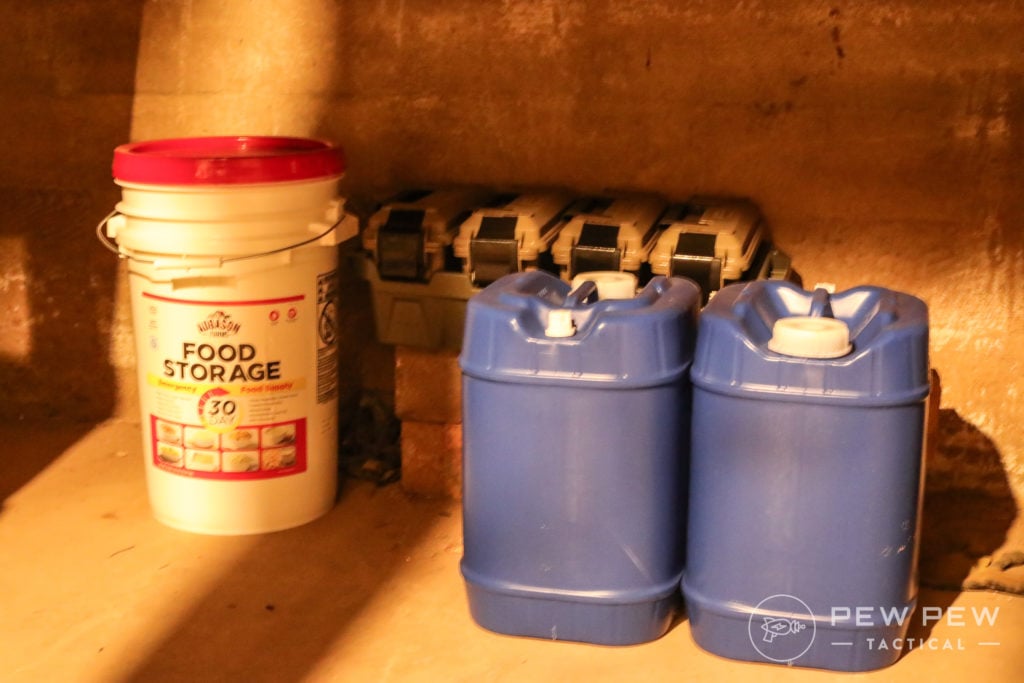
If you do all this, I think you’ll find that you’ll end up with some incredibly delicious meals that you can be proud to truly call your own.
Are there other MRE recipes you’ve discovered? Let us know in the comments below! If you’d just rather buy your own, see what we think are the Best MREs.

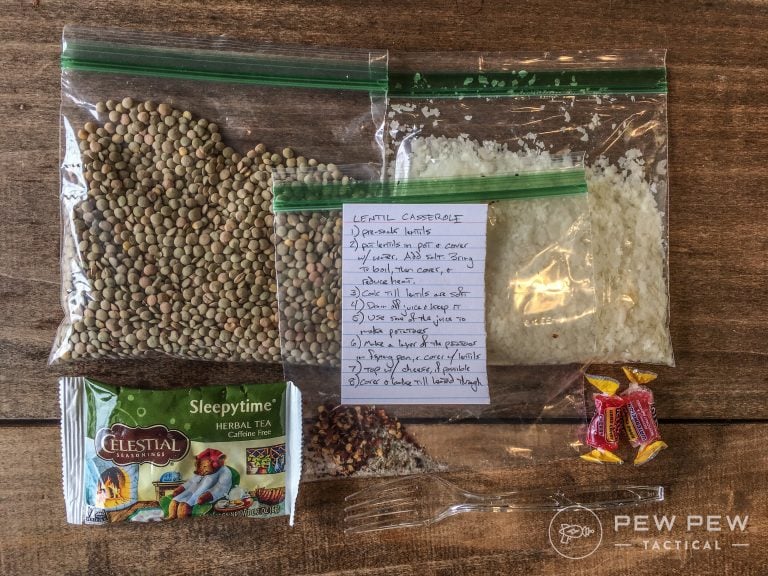











11 Leave a Reply
What are the ingredients for the dumpling mixture in the dumpling and soup?!
I really liked the philosophy in this article - we have all the bells and whistles for food storage (freeze-dryer, chamber sealer, etc.) BUT so many times 'simpler is better'...and cheaper. Great use of logic to use regular foodstocks to stretch the dollar.
Hi, does packaging in the vacuum sealed bag extend the expiration date on the prepackaged contents? Like the potato flakes or cup a soup, etc? Or is the date if the new expiration the least of its components?
Yes, it does, the date is often a "sell by" date. Vaccuum sealing will lengthen the time the food will be good for years. We have sealed all kinds of stuff that is supposed to go bad quickly like crackers, nuts, and chocolate. All of them have been yummy two years past their "sell by" date. ( We will keep testing as time goes on)
These were all great suggestions, even if they needed some prep. So perhaps they are 'quasi-mre's'?
no u
You keep using that word. I do not think it means what you think it means: MRE. Meals Ready to Eat. READY.
Not 1 of these was remotely "ready to eat" i feel like missed an important part of what an mre is.
Haha, yes, MREs are most certainly NOT health food. I made them with overnight backpacking trips in mind, so there is a heavy emphasis on carbs and calories. That being said, the entrees themselves are relatively healthy. It's the add-ons (Nutter Butters, gummies, etc.) that are the the unhealthier treat.
I've found that out in the woods after backpacking 20 miles with a 35 lb pack though, that I'm ok with eating something slightly unhealthy. At that point I just want to eat. And a lot.
When representatives from the American Diabetic Association reviewed this article, they had a seizure.
Great article. Love the ideas and different content.